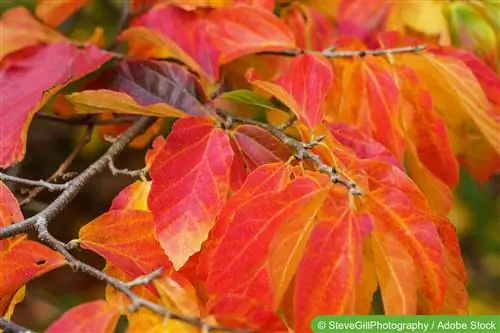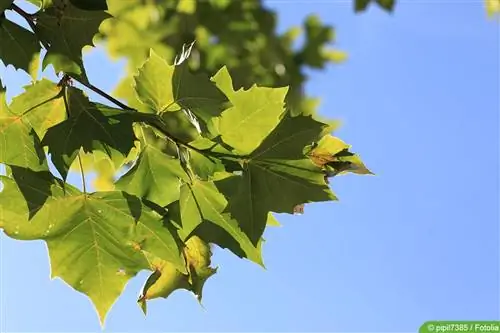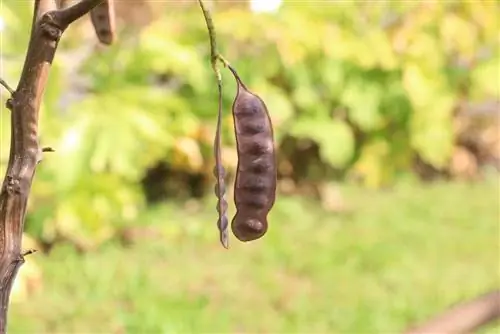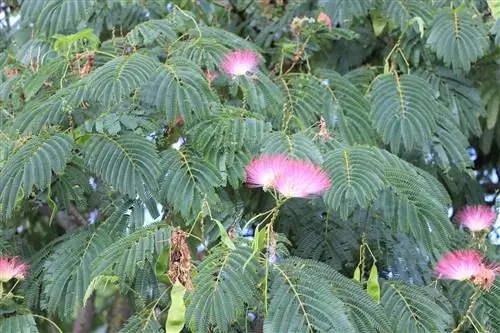- Author admin [email protected].
- Public 2023-12-17 03:39.
- Last modified 2025-01-24 12:45.
The ironwood tree (Metrosideros) is known in many variations and belongs to the myrtle family or the witch hazel family, which attract attention with its beautiful flowers. The ironwood tree is native to Iran and the Caucasus; it was named Parrotia after the German botanist Friedrich W. Parot (1792-1841).
Varieties of the ironwood tree include:
- Lophira alata
- Metrosideros vera
- Argan Tree
- Parrotia persica
Characteristics of the Ironwood Tree
The ironwood tree is a deciduous shrub, but can also be described as a small tree. It reaches a height of up to 10 meters. If the ironwood tree has a single trunk, it tends to branch directly above the surface of the earth, which is why it is also called a shrub. The trunk shows a scaly bark that peels off and looks similar to that of a sycamore tree. The young branches have a hairy surface. By the way: Because the wood is so heavy that it sinks in water, it is called the ironwood tree.
The leaves of the Parrotia grow alternately, they are around 10cm long and have either an ovoid or elliptical-round shape. The tree flowers from January to March before the leaves develop. When the flower buds open between June and August, eight to ten head-shaped flowers appear. Elongated and shiny light brown seeds sit in the seed capsule. In autumn, the ironwood tree shines yellow, orange or orange-red, which is another reason why it is very popular with garden owners. The older the tree gets, the more beautiful it becomes and the more expansive its crown becomes.
Ironwood Tree Location
If the ironwood tree is in a wind-protected and sunny location, it will grow and thrive best. Young trees have branches that point upward like a funnel. The older the tree gets, the more a large crown forms. Since most ironwood trees in the garden grow with multiple trunks, they can reach a circumference of up to 12 meters wide. As a young tree, the ironwood tree grows relatively slowly, only gaining significant weight after a few years. That's why the location should be assessed correctly from the start, this type of tree doesn't like it at all when it has to be replanted again after years.
Tip:
Because of its beautiful foliage color, it is particularly effective as an eye-catcher in the garden.
The soil at the location should be nutrient-rich, loose and permeable. It can also tolerate slightly acidic clay soil well. However, the ironwood tree can adapt very well and can therefore also grow on moist sandy soil. However, no matter how moist the soil is, it doesn't like waterlogging. The lighter the soil, the stronger the color of the leaves will be in autumn. Since the ironwood tree develops shallow roots, no other plants can be planted near the base of the tree. Here it is better to apply a layer of mulch, as this not only looks nicer but also retains moisture in the soil. Some varieties of iron trees can also be placed in the winter garden or as a small indoor tree. Some garden owners would like to use the parrotia as an espalier tree, and that is also possible. Thanks to its shallow roots, it can also be used in areas with less soil, but sometimes new roots form above the surface of the soil, which then grow downwards and search for the soil there.
Caring for the ironwood tree
Ironwood trees are considered uncomplicated and robust. If the soil conditions and its requirements for sun and sheltered location are met, it doesn't actually need any further attention. It also doesn't need to be cut back if the location was chosen so that it can develop unhindered. It is also rarely attacked by pests or diseases.
Due to its initially slow growth, the ironwood tree can initially be grown in a pot. This means it will be an eye-catcher on the terrace for a while, and later it can be planted out in the garden on site. In the pot it needs protection from frost and severe sub-zero temperatures. If the winters are mild, he can get by without it.
Watering and fertilizing
If the ironwood tree is in a pot, it obviously needs to receive regular water and nutrients. Specimens planted in the garden, on the other hand, get by with the normal moisture of the soil. If there are particularly hot and dry summers, it can get its share of water with general flower watering. Its nutrient requirements are low. Outdoors, it can be supplied with a portion of compost in the spring or mineral fertilizer as directed. From September onwards, additional fertilizer will no longer be fed.
Propagate Parrotia
If half-woody shoot tips are cut in summer and placed in a mixture of peat and sand at temperatures of 22-25°, they can root. If they are dipped in rooting powder beforehand, the roots will form better and faster. However, with this process you have to be a little lucky so that the roots develop. It is of course safer to buy a young plant from a tree nursery or gardening store. Specimens from 40cm up to 150cm can be purchased here. They are often offered as small copies in hardware stores for a few euros.
What you should know about the ironwood tree in brief
The ironwood tree is an easy-care, robust plant. It can have a permanent place in a heated winter garden. Otherwise, keeping in a bucket is a good option. In the summer you can put the plant outdoors, but it has to spend the winter in a warm place. In warm locations you can also overwinter the ironwood tree outside, but it is well protected.
Young trees or bushes grow slowly. However, growth increases after two to three years. The ironwood tree is one of the witch hazel plants and, like all of them, once rooted it should no longer be transplanted. The plant does not require any special care and is hardly affected by diseases and pests.
Care
- The ironwood tree likes nutrient-rich, slightly acidic clay soils that must be loose and permeable.
- Because it is very adaptable, it also grows on sufficiently moist sandy soils. The autumn color is more intense on light soils.
- The tree reacts sensitively to waterlogging. Normal potting soil can also be used for indoor cultivation.
- The location should be bright and sunny, but partial shade is also tolerated well.
- Lack of light leads to reduced flower formation. A good location results in dense and compact growth.
- In early summer you keep the ironwood tree a little drier so that it produces more flowers. Otherwise, the soil must be kept constantly moist.
- The water requirements of potted plants are high. The earth should never dry out completely.
- Fertilization is carried out every 10 days from March to September with high-quality complete fertilizer for potted plants.
- You can also use slow-release fertilizer in March and refresh it again in June.
- Ironwood trees should be repotted annually. The best time for this is late winter. You use a slightly larger container.
- The potting soil should contain coarse grains, i.e. lava grit, gravel, grit or expanded clay.
Wintering
- Overwintering is best done in a bright and cool place at around 5 to 10 ºC. Too much heat impairs or even prevents flower formation.
- Young shoots freeze easily.
- When the winter is cool, an energy-saving rest phase occurs, from which the plant wakes up in spring with full energy and gets started.
- The short-term minimum temperature is 0 ºC.
- Even during wintering, the ironwood trees must not dry out, otherwise they will lose their leaves and become bald.
Cut
- The ironwood tree grows best without pruning.
- If you want to train it to become a standard tree, it should be cut immediately after flowering.
- Most of the time only minor corrections are necessary. These can be done in summer and also at the end of winter.






